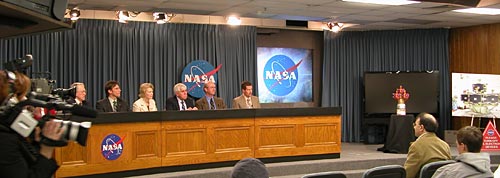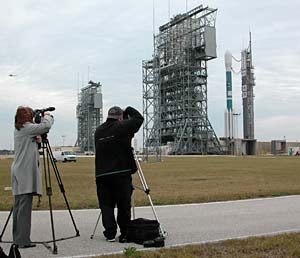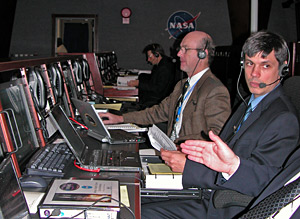UC Berkeley Web Feature
 Thursday's preflight press briefing included THEMIS project manager Peter Harvey from UC Berkeley (second from right at desk) among a panel of NASA and Air Force officials. (Bob Sanders photos) |
THEMIS launch delays have silver lining for families
Editor's note: Minutes prior to Friday's (Feb. 16) scheduled liftoff, NASA scrubbed the launch because of high-level wind conditions. After a 24-hour delay to recycle to process, the next 18-minute launch window begins at 3:01 p.m. PST on Saturday, Feb. 17.
CAPE CANAVERAL, Fla. – A storm front that moved through northern Florida on Tuesday, forcing a 24-hour delay in the scheduled launch of five UC Berkeley-built THEMIS satellites, was a mild inconvenience for many space scientists here. But it proved a boon for their families, who spent Thursday further exploring the John F. Kennedy Space Center or splashing in the hotel pool in sunny, 70-degree weather.
"No one was upset about the delay," said THEMIS project manager Peter Harvey of UC Berkeley. At Thursday morning's launch readiness review, a pre-launch ritual attended by more than 100 NASA managers and engineers, industry representatives and Air Force officers, Harvey and others provided assurances that all the key players were "clean and green" for Friday's scheduled launch at 6:05 p.m. EST (3:05 PST). But while the rocket and satellites got a green light, unsettled weather remained a complicating factor.
 Photographers record the rollback of the launch tower, revealing the Delta II rocket (right) that will lift the THEMIS satellites into space. |
Friday morning, after the NASA launch tower rolled back to reveal the blue and
white Delta II rocket that will carry the satellites into space, Vassilis Angelopoulos, UC Berkeley's THEMIS principal investigator, said, "It's looking cool. We're very confident that the launch will go OK."
But that doesn't mean UC Berkeley scientists aren't anxious.
"For us," said Angelopoulos, "the stressful time is when the probes are released from the probe carrier," a device designed by Swales Aerospace specifically to launch the THEMIS probes by spinning them off like whipped cream from a beater.
"All our eggs are in one basket with that release mechanism, which is
flying for the first time - it's a one-of-a-kind design," he said.
Angelopoulos said he'll be waiting to hear from UC Berkeley's Mission Operations Center at the Space Sciences Laboratory an hour and a half after the launch to confirm that all probes are working properly.
The $200 million NASA science mission is aimed at pinpointing the location of the trigger for aurora substorms, explosive energy releases in Earth's magnetosphere that make the aurora dance around. Doing so will help scientists understand full-blown solar storms that can disable spacecraft in orbit and blow out electrical power grids on Earth. The full-scale storms also disrupt radio communication and navigation systems, endangering airliners flying near the pole and increasing space radiation to levels that can harm astronauts at the International Space Station.
Tuesday's seasonal storm was a long, narrow string of thunderheads that passed overhead and quickly moved out to sea, leaving clear, sunny skies behind. But it's arrival mid-afternoon that day wreaked havoc with the fuel loading of the Delta II rocket, atop which the THEMIS satellites now sit, on Pad 17-B at the southern end of Cape Canaveral Air Force Station. Because the storm required evacuation of the launch pad to avoid lightning, fueling of the second stage with so-called "hypergolic propellants" - two chemicals that ignite spontaneously when combined - had to be postponed.
 Four hours before the scheduled launch, UC Berkeley's Peter Harvey and Vassilis Angelopoulos (right) monitor the THEMIS probes in the mission operations room at Cape Canaveral Air Force Station. |
The delay pushed back to Thursday all L-1 (L minus 1) activities - that is, preparations scheduled for the day before launch. Those included not only the 9 a.m. launch readiness review, but also the standard press conference and science briefing. With Harvey participating in the former, and Angelopoulos in the latter, these events provide the last chance before launch to discuss the meaning of the mission for the general public.
Because launch delays are common, this week's push-back barely concerned some 80 scientists from around the world who were participating in a two-day conference on THEMIS science at the nearby Radisson Resort at the Port. Those determined to see the launch, however, had to scramble to rebook rooms for another night and reschedule plane connections.
Meanwhile, NASA's Guest Services gave free admission to the Kennedy Space Center Visitor Complex to VIPs from UC Berkeley; NASA Goddard Space Flight Center; United Launch Alliance, which built the Delta II rocket; and Swales Aerospace, which built parts of the five THEMIS probes. The complex offers IMAX space films, theatrical shows, a Rocket Garden containing 10-story high rockets, a Gemini program capsule to view, and more. Many guests also took advantage of reduced prices to take a guided tour of the Kennedy space center, a 219-square mile complex dominated by the 525-foot-tall vehicle assembly building, where the space shuttle is mated with its rocket tank and boosters before launch.
Nahide Craig, UC Berkeley head of education and public outreach for THEMIS, led a teacher workshop here earlier in the week, but by Thursday was touring the space center and hoping to do a bit of bird watching. Kennedy is in the middle of the Merritt Island National Wildlife Refuge, home to bald eagles, ospreys, ibises and storks, not to mention alligators.
The NASA guests - up to 500 in all - include nearly 150 associated with UC Berkeley. These include the families of the 38 campus scientists and staff who worked long hours for three and a half years to get the THEMIS satellites done on time and on budget. For the launch, all VIP guests will gather at a special viewing site from which they can see the rocket take off in the last rays of the setting sun.
Despite all the positive signs, Angelopoulos, Harvey and their colleagues were holding their breath, hoping that the Delta II's solid history of success - only two unsuccessful launches out of 126 - continues for yet another launch.
To celebrate, Angelopoulos organized a beach party for many of his guests, including relatives from Greece who were not able to get into Kennedy for the launch. The viewing site at Jetty Park in Port Canaveral, a nearby cruise and cargo port, "provides a better view than you would get from Kennedy," he said.

